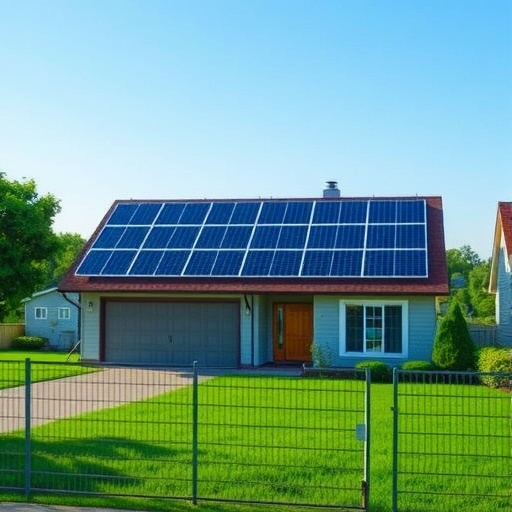Approximately 60% of U.S. households could achieve an average reduction in electricity costs of about 15% should they choose to invest in a solar-battery system. This projection considers the annualized costs for installation and maintenance of the equipment. More alarmingly, 63% of families would be equipped to endure local or regional blackouts, achieving a level of independence by meeting roughly half of their electricity requirements through solar energy during outages. This potential for self-sufficiency is especially appealing given the backdrop of incessantly rising utility rates and the increasing likelihood of severe weather events that lead to power disruptions.
According to Ram Rajagopal, the study’s senior author, these financial and logistical advantages are vital as many households seek ways to offset higher utility bills while also preparing for potential power outages. The aging U.S. electricity infrastructure is only exacerbated by the escalating intensity and longevity of severe weather, such as hurricanes and heatwaves, which contribute to widespread blackouts. This context underscores the growing importance of solar and battery systems for families who seek both economic savings and security.
.adsslot_vlLM1OJUWF{ width:728px !important; height:90px !important; }
@media (max-width:1199px) { .adsslot_vlLM1OJUWF{ width:468px !important; height:60px !important; } }
@media (max-width:767px) { .adsslot_vlLM1OJUWF{ width:320px !important; height:50px !important; } }
ADVERTISEMENT
The recent study, which was published in the prestigious journal Nature Energy, delves into the accessibility of solar photovoltaic (PV) and battery storage capabilities among more than half a million U.S. households. This high-resolution assessment allows the authors to derive significant insights about potential savings and resilience across various demographics, highlighting a crucial intersection between energy economics, policy, and consumer behavior in the face of climate change.
Significantly, the One Big Beautiful Bill Act, signed into law on July 4, will bring a halt to the residential clean energy tax credits established by the Inflation Reduction Act of 2022. These tax credits currently allow homeowners to deduct up to 30% of their solar panel and battery installation costs from their federal taxes, yielding substantial rebates for investments in renewable energy. As the deadline looms at the end of the year, families may find themselves in a race against time to harness these financial incentives before they are eliminated.
Under the new paradigm, households equipped with battery packs can store their solar energy for later use, particularly during nighttime hours when energy prices are highest. This shifts the strategy from merely producing excess energy to maximizing savings by utilizing stored energy when it is needed most. This shift in perspective highlights the evolving dialogue surrounding energy independence, sustainability, and financial prudence in energy management.
Despite the substantial benefits, there is an inherent disparity in the distribution of solar-battery advantages across different regions of the United States. Areas with frequent power outages typically experience diminished impacts from solar-battery systems because the economic effectiveness of these systems can vary greatly based on local utility rates, renewable energy resources, and the probabilities of blackout events. The study articulates a pressing need to ensure that access to affordable energy solutions aligns with the regions experiencing the greatest distress due to expensive electric bills and unreliable power supplies.
As climate change continues to exacerbate power supply issues and increase costs, the development of tailored economic incentives, financing mechanisms, and community-level initiatives aimed at bolstering energy access for disadvantaged neighborhoods becomes crucial. Innovations such as mobile energy storage units that can move into specific areas during outages represent a potential avenue for enhancing grid resilience and affordability for communities with limited access to clean energy solutions.
Consequently, the unfolding circumstances surrounding solar energy adoption and battery systems demonstrate the dynamic nature of the U.S. energy landscape. With the cost of storage technology steadily declining, coupled with rising electricity rates and fluctuating tax incentives, continuous research and dialogue among policymakers will be paramount for developing equitable and sustainable energy practices.
The pressing nature of climate-related challenges and the realities of energy management demand that families assess their options strategically. For many, investing in solar-battery systems could simultaneously yield economic benefits and improve resilience in an era of increasing environmental instability. However, the clock is ticking, with federal policy shifts looming, and now is the time for proactive measures to secure a future of affordable, clean electricity for all American households.
Subject of Research: Solar energy and battery storage for U.S. households.
Article Title: Solar and battery can reduce energy costs and provide affordable outage backup for US households.
News Publication Date: 1-Aug-2025.
Web References: 10.1038/s41560-025-01821-w.
References: Nature Energy.
Image Credits: Stanford University.
Keywords
Solar energy, Energy storage, Batteries, Electrochemical cells, Financial incentives, Economic decision making, Electricity.
Tags: aging electricity infrastructurebattery storage systemselectricity expense reductionenergy independence during outagesenvironmental concerns and electricityfederal tax incentives for solarRenewable energy solutionsresilience against blackoutsrooftop solar panelssolar energy savingsStanford University study on solarU.S. households energy costs





